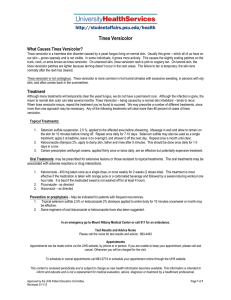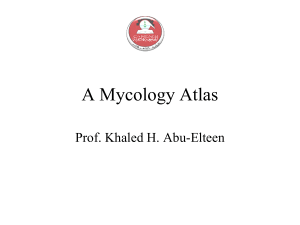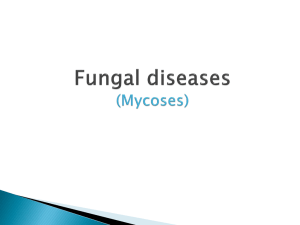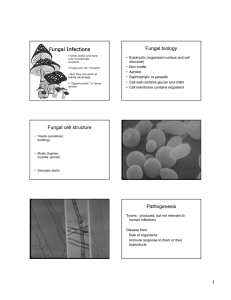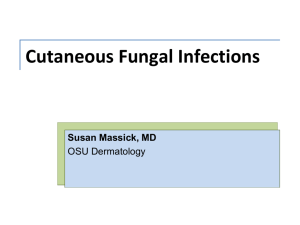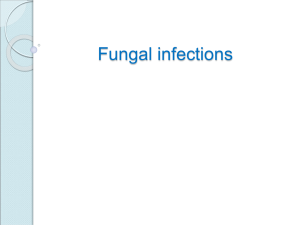Dermatophytes
advertisement
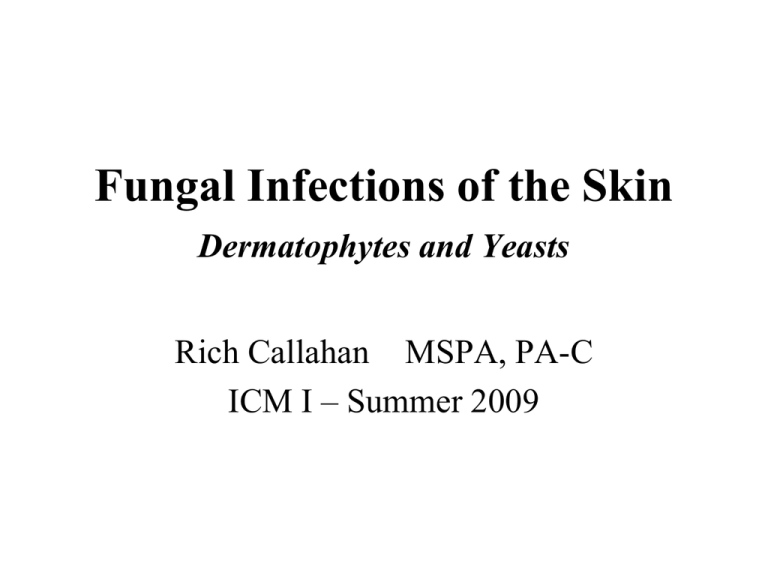
Fungal Infections of the Skin Dermatophytes and Yeasts Rich Callahan MSPA, PA-C ICM I – Summer 2009 We’ll review the 3 most common fungal skin infections seen clinically • Tinea, or dermatophyte infection. “Ringworm.” • Tinea Versicolor, a cutaneous yeast infection with malassezia furfur. (They renamed tinea versicolor to pityriasis versicolor a few years ago, but in everyday practice most everyone still calls it tinea versicolor) • Cutaneous Candidiasis, a cutaneous yeast infection with candida species. Superficial Fungal Infections Break down into 2 Categories: 1.) Yeasts • Single cells with asexual budding • Candida Albicans – causes cutaneous candidiasis. Affects skin, oropharynx, genitalia – likes humidity • Malassezia furfur – causes tinea versicolor – likes moisture and lipidrich environment 2.) Molds, or “dermatophytes” • The “tineas” or “ringworm” • Active growth phase forms filaments, or hyphae which infiltrate keratinized skin • Infect skin, hair and nails • Caused by epidermophyton, trichophyton, microsporum spp. Cutaneous Candidiasis • Basically a “yeast infection” affecting moist, warm occluded skin anywhere on the body • Like groin creases, genitals, axillae, inframammary, perianal, interdigital spaces, occasionally presents as folliculitis Candida is same species causing classic “yeast infection” affecting reproductive tract of female patients Predisposing Factors • Immunosuppression -AIDS -Malignancy -chemo • Environment -Occlusion, heat -Moisture, maceration • Diabetes • Infants • Medications -antibiotics -oral/systemic steroids • Pregnancy Cutaneous Candidiasis – Clinical Presentations • • • • Intertrigo Angular Cheilitis Balanitis Vulvovaginitis Candida Intertrigo – Clinical Presentation • Brightly erythematous, moist, macerated skin • Often has milky, whitish, adherent film and characteristic yeasty odor • Main areas of skin change often have surrounding “satellite” lesions – small papules and pustules with areas of normalappearing skin in between Cutaneous Candidiasis Diagnosis • KOH preparation yields classic appearance of budding yeast pseudohyphae and spores • Can be confirmed by fungal culture when necessary Candida Intertrigo - Treatment • • • • Must dry out chronically moist area Showers, baths, soaks Use powders sparingly Helps to try and cool the affected environment • Topical anti-yeast medications • Systemic: Diflucan; Sporanox Angular Cheilitis • As we age skin starts to sag over lateral oral commissures creating environment of moisture and occlusion. • Presents as erythematous, cracked, crusted, itchy/painful lesions at corners of mouth. • Treatment consists of low-potency topical steroids, topical anti-yeast medications Candidal Balanitis/Vulvovaginitis • “Yeast” infection of the genitals • Can follow sexual activity and many other activities altering various microenvironments around the body • Usually represents overgrowth of pre-existent flora • Characterized by burning, itching, pain, discharge, dysuria, dyspareunia • Topical/systemic anti-yeast medications. Dermatophytes aka “Ringworm” • Many species can infect skin, hair and nails (any non-viable keratin) • Trichophyton Rubrum by far the most common • Can infect hair follicle unit and become trichomycosis • When confined to skin, is called epidermomycosis • Nail infection = onychomycosis The Tineas – Occur from Head to Toe • • • • • • • T. Capitis – hair/head T. Faciale – face T. Barbae – beard T. Manus – hands T. Corporis – body T. Cruris – groin T. Pedis – foot The Tineas – Clinical Presentations The Tineas - Diagnosis • KOH preparation • Fungal Culture • KOH Prep most often used in clinical practice: Skin scrapings from affected area placed on glass slide w/KOH solution + heated. In 5-10 minutes keratin in specimen broken down to reveal fungal hyphae and spores. • Dermatopathology: Skin biopsy with PAS stain can yield fungal forms on histologic analysis The Tineas - Treatment • Topical Antifungals – the azoles (econazole, sertraconazole, clotrimazole, etc. • Terbinafine • Ciclopirox • Naftifine • Systemics: Terbinafine, Itraconazole, fluconazole, griseofulvin Tinea Versicolor, aka Pityriasis Versicolor • Name of causative organism has changed – formerly known as pityrosporum ovale, now called malassezia furfur • Lipophilic yeast – colonized skin, hair and follicles roughly around puberty • Has been implicated in terms of having a role in the development of seborrheic dermatitis – as of yet to be clearly defined Tinea Versicolor • Epidermomycosis with m.furfur yeast on children and younger adults • Prefers areas of high sebum production on trunk: chest/back/axillae • Presents as scaling pink macules and patches on fair skin and scaling, hypopigmented patches on tan skin. • Often mildly pruritic or asymptomatic • Normal resident of skin flora – more opportunistic than contagious T. Versicolor - Diagnosis • Often a clinical diagnosis based on classic history/appearance • KOH prep yields classic “spaghetti and meatballs” appearance of budding yeast forms and spores • Dermatopathology: Skin biopsy with PAS stain often shows budding yeast forms • Patients with chronic TV over many years often spotted with hypopigmented macules T. Versicolor – Treatment • Topicals: Selenium sulfide/ketoconazole shampoo, topical azole antifungals/terbinafine. • Systemics: Ketoconazole pulse dosing, itraconazole, fluconazole • Often chronic course requiring periodic maintenance/suppressive therapy • Chronic, severe TV recalcitrant to treatment can be presenting sign of HIV
